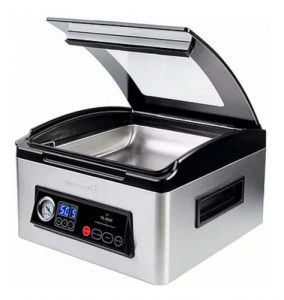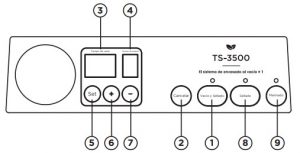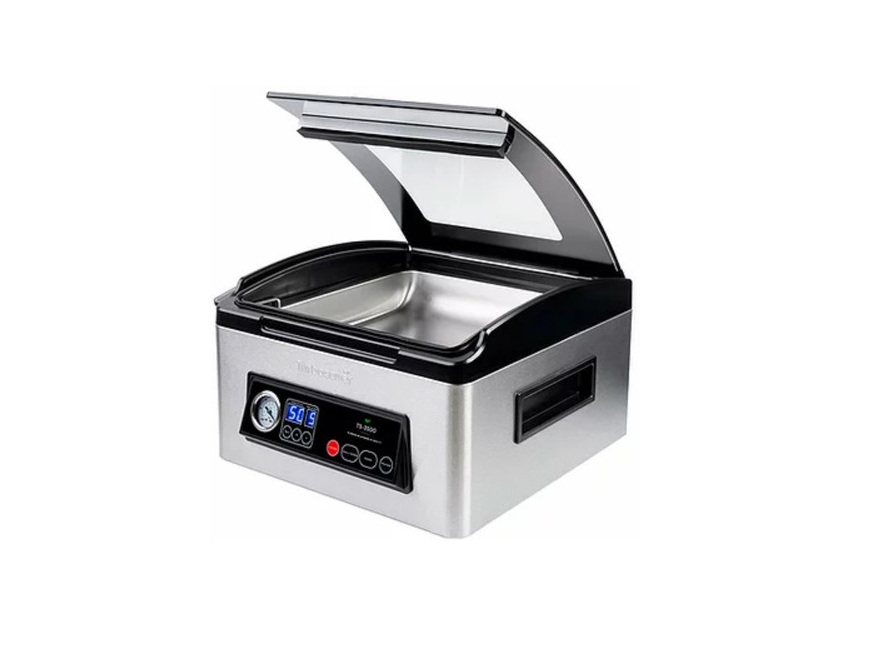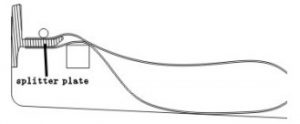Turbosaver Vacuum Packing Machine User Manual

IMPORTANT SAFEGUARDS
When using this electrical appliance, safety precautions should always be observed, including the following:
READ ALL INSTRUCTIONS
- Carefully read all of the instructions before using this appliance and save for future reference.
- Before plugging cord into wall outlet, or disconnecting, make sure that the cover of the machine is in unlocked condition, and unplug from outlet when not in use or before cleaning.
- This appliance is not a toy, when used by or near children, close attention is necessary, and store this appliance to a safe place, out of the reach of children.
- Do not use any bags or attachments not recommended or appointed, and don’t use this appliance for other purpose except its intended use.
- Stop using the machine immediately if the cord is damaged and have it replaced by a professional.
- Keep away from moving parts.
- Do not contact the hot sealing element located on edge of the top cover of this machine. It is hot and may get burn.
- Do not try to repair this appliance by yourself.
- Don’t use the appliance if it has fallen or appeared to be damaged.
- Avoid to do the following: pull or carry by the cord, use cord as a handle, close a door on cord, or pull cord around sharp edges or corners. Do not operate appliance over cord or cord / plug is wet.
- Keep away from hot gas, heated oven, electric burner or any other hot surfaces. Do not use this appliance on wet or hot surface or near a heat source.
- It’s better not to use an extension cord with this unit. However, if one is used, it must have a rating equal to or exceeding the fating of this appliance.
- When disconnect, to avoid any injury, please unplug by grasp the plug, not the cord.
- Before plugging appliance in or operating, make sure your hands are dry and safe to do the actions.
- When it In “ON” or working position, always be on a stable surface, such as table or counter.
- It’s no need to use any lubricant, such as lubricating oils or water, on this appliance.
- Do not immerse any part of this appliance, power cord or plug in water or any other liquid.
- Do not use this appliance outdoors or on a wet surface, it’s recommended for household, indoor use only.
- This appliance can’t be used by children aged from 8 years and above and persons with reduced physical, sensory or mental capabilities or lack of experience and knowledge if they have been given supervision or instruction concerning use of the appliance in a safe way and understand the hazards involved.
- Children should be supervised to ensure that they do not play with the appliance.
- If the supply cord is damaged, It must be replaced by the manufacturer, its service agent or similarly qualified persons in order to avoid a hazard.
- Cleaning and user maintenance shall not be made by children without supervision.
CAUTION:
SAVE THESE INSTRUCTIONS FOR HOUSE HOLD USE ONLY.
CONSTRUCTION AND FUNCTIONS

- Vacuum&seal: At stand-by condition, it starts the automatic operation of vacuuming the bag and then automatically seals the bag when vacuum is complete;
- Cancel: At working (vacuuming or sealing operations) condition, it stops the machine.
- Vacuum Time Screen: This screen is the numeric display apparatus and provides two functions
- show that the progress of vacuuming;
- show that setting vacuum time.
- Seal Time Screen: This screen is the numeric display apparatus and provides two functions
- show that the progress of sealing;
- show that setting sealing time.
- Set: To chose setting the vacuum times or sealing times.Vacuum times set range:20-99s;sealing times set range:3-9s.
- “+”: To increase the vacuum times or sealing times.
- “-“: To decrease the vacuum times or sealing times.
- Seal: This button provides also two functions:
- To seal the open end of a bag, used to make a bag from a bag roll;When seal the bags, the machine will start the vacuuming firstly about 20 seconds to keep tightness of the sealing bar before it seal the bags.
- When the automatic “Vacuum &seal” function is in operation, this button stops the motor pump when the vacuum pressure reached about -25 in Hg which indicated on the pressure gauge, press the “SEAL” button to seal the bags immediately so that less vacuum pressure inside the bag can be achieved by the operator to avoid crushing for delicate items.
- Marinate: Work on vacuum 99s and no seal.

- Vacuum Gauge:Represents the vacuum level inside the chamber.
- Gasket Keep air away by forming vacuum chamber with gasket. Clean and dry or replace it when distorted or broken.
- Sealing element: Teflon-coated heating element which is hot and seals the bag.
- Sealing strip: Place the bag to be sealed over this strip, Clean and dry or replace it when distorted or broken.
- Bag Fixer : Fix the bag when vacuum and sealing.
- Power switch : ON/OFF power.
- Bag splitter plate : Splitter the bag mouse toavoid the air cann’t be draw out completed from the bag.
OPERATING INSTRUCTIONS
- Set vacuum timeTouch the vacuum”+”and”-” to increase or decrease vacuum time. According to the different food and bag size to choose suitable vacuum time,Vacuum time may refer to the following vacuum time selection table.Vacuum Time Set-up Guide
No
Applications
Examples
Vacuum Set Time (S)
1
General applications Ex-factory set-up, good for regular bag size, and all types of food, meat 60
2
Light packaging of the soft and the crushables Bread, potato chips, Fruits, etc in loose package 20 ~ 40
3
Regular size of bags All types with bags sized smaller than 22 cm x 30 cm 40 ~ 60
4
Large size of bags in bulky pack For bulky, large bags 30 x 33 cm ull of things 60 ~ 80
5
Tight packaging; liquid packaging Soups, sauces… 60 ~ 80
6
Extra tight vacuum packaging Marinating of food, extra tight vacuum packing 99
- Set sealing timeTouch the seal”+”and”-” to increase or decrease sealing time.According to the thickness and materials of the bag the environment temperature food type to choose suitable sealing time. Sealing time may refer to the following the sealing time selection table.Sealing time Set-up Guide
No
Applications
Examples
Sealing Set Time(S)
1
Normal type Nylon vacuum packaging bag Nylon type bags, working in room temperature and dry bags. 6 seconds
2
Soft bags (not vacuum type bags) PE bags or OPP bags 3 ~ 4 seconds
3
Very thin vacuum bags, or wet soft bags Wet PE bags; or thin Nylon bags 4 ~ 6 seconds
4
Vacuum bags but in cold weather or outdoor use In windy day outdoor use, or in a room below 12 degree C 6 ~ 7 seconds
5
Moist/wet bags, or in cold weather condition Wet bags or with moisture inside the bags 7 ~ 8 seconds
6
Aluminum foil bags, or paper bags Aluminum foil bags, or paper bags 8 ~ 9 seconds
General Instructions:
No
General Instruction
1
Always expel more air out of the bag before closing the lid and starting the vacuum pump 2
Always place the open end of the bag flat and straight on the sealing bar, do not ovelap or wrinkle 3
Large and empty bag needs longer vacuum pumping time; Smaller bag vacuums quicker 4
Increase the vacuum pumping time for a tighter package 5
Fresh Fruit and vegetables are still alive and can breathe gas, thus are not recommended to pack under vacuum. Vacuum pressure willl squeeze and harm them 6
For best marinating effects, repeat the vacuum pumping 2 o 3 times 7
Always checking the melt seal line to ensure it is clear, flat, evenly melted. Add one or two more seconds 8
Add one or two more seconds in winter time and cold days for better sealing result 9
Keep the open end of the bag clean and dry; add two more seconds if the open end of the bag is wet - Making a bag with bag rollPut out the power cord and plug to the appliance and a wall outlet,Switch turn “ON”,Vacuum screen and seal screen will display working time.Set suitable vacuum and sealing time.
- Pull out the bag roll and cutter to the suitable length you want.
- Open the cover put one end of the bag on top of the sealing element and make sure that the entire short end is under bag fixer.
- Pull down the cover and touch “Seal” button to start make the bag. The vacuum screen flashes display “0” and pump will work a few seconds,then the seal screen display counts down to “0”,then “sealing” indicator LED flashes a few seconds,indicator LED off if finish.
- Lift the handle to open the cover. Remove the finished vacuum bag. The vacuum bag is now ready to be used for vacuum packing.

II. Vacuum packaging with a bag
- Put the items inside the bag.Clean and straighten the open end of the bag, make sure no dust, wrinkle or ripples.Note: Expel the extra empty air out of the bag after the bag is placed into the sealing bar inside the chamber, this is a very important point to get a good vacuum sealed bag.
- Open the cover put one end of the bag on top of the sealing element and make sure that the entire short end is under bag fixer.Note: When put the bag into the vacuum chamber, Please put the bag mouse encircle the splitter plate to avoid the air can’t be draw out completed from the bag.

- Check the screen to confirm vacuum and sealing time according to the type of food and bag.
- Pull down the cover and touch “Vacuum&Sealing” button to start the unit start to vacuum and will seal the bag automatically . The vacuum screen display counts down to “0” ,then the seal screen display counts down to “0”,then “vacuum&sealing” and “sealing” indicator LED flashes a few seconds,indicator LED off if finish.
Note: The appliance reaches a very high vacuum pressure during the vacuum sealing process. In order to avoid that sensible contents is influenced by the high pressure, keep an eye also on the vacuum gauge and press the Manual Seal button, if you want to interrupt the process before time. In such case, the appliance turns off the pumping and switches to sealing of the vacuum bag.
5. Lift the handle to open the cover and take out the packed bags.
NOTE: For best sealing effect, it is better to let the appliance cool down for 1 minute before using it again. Wipe out any excess liquid or food residue in the vacuum chamber after each bag packaged.-The machine can be used continuously. -Your appliance can work all on the specific bags. -Cut the bag straight across with scissors to open a sealed bag.
Working on marinate
- Put the marinate items on container.
- Lift the handle to open the cover and put the container on chamber.
- Pull down the cover and touch “Marinate” button to start the unit start to vacuum. The vacuum screen display counts down to “0” ,then “marinate” indicator LED flashes a few seconds,indicator LED off if finish one circulation.
- Repeat step 3 two more.
- Lift the handle to open the cover and take out the items.
Note: To ensure there is no air leaking from the lid,always hold down the lid tight on top of the chamber a few seconds when starting the machine.
CLEANING AND MAINTENANCE
Vacuum sealer:
- Always unplug the unit before cleaning.
- Do not immerse in water or any other liquid.
- Avoid using abrasive products or material to clean the unit, for they will scratch the surface.
- Use a mild dish washing soap and a warm, damp cloth to wipe away food residue or around components.
- Dry thoroughly before using again.Note: The foam gaskets around the vacuum chamber should be dried thoroughly before re-assembling, when re-assembling, is careful to prevent any damage, and assemble as original position to ensure no vacuum leaking.
Vacuum bags
- Wash bags in warm water with a mild dish washing soap.
- When wash bags in dishwasher, turn bags inside out and spread them over top rack of dishwasher, so entire surface is exposed to the washing water.
- Dry thoroughly before reusing.
IMPORTANT: To avoid possible illness, do not reuse bags after storing raw meats, raw fish or greasy foods. Do not reuse bags that have been microwaved or boiled.
Storing Your Vacuum Sealer:
- Keep the unit in a flat and safe place, out of the reach of children.
TROUBLESHOOTING
|
Problem |
Solution |
| Vacuuming but seal function is not good | Check if the sealing time is sufficient? If not, please reset the sealing time. |
| Check if the heating element damage and good setting or not? If damaged, please exchange the heating element and make sure it is well installed. | |
| Check if the sealing strip damage or well installed? If damaged, please exchange the sealing strip and make sure it is well installed. | |
| Check if the edge of the bag has liquid? If yes, please clean the edge of the bag and try again | |
| Seal function is good but cannot vacuuming | Check if the vacuuming time is enough? If not, please reset the vacuuming time |
| Check if the food with sharp angle? If yes, please packing the angle with safe paper before vacuuming the food | |
| Check if the edge of the bag has liquid? If yes, please clean the edge of the bag and try again. | |
| Check if the sealing strip damage or well installed? If damaged, please exchange the sealing strip and make sure it is well install. | |
| Bag inflation after vacuuming | Check if the good is belong to easy corrosion foods? All the easy corrosion goods are need to be frozen or refrigerated after vacuuming so that it can prolong it’s shelf life. But vacuuming doesn’t guarantee the foods will never spoil. |
| Check if you packed the fresh vegetables or fruit and seed food? All fresh vegetables or fruit and seed are not suitable to storage under room temperature after vacuumed, they have photosynthesis and respiration. Suggest to storage them in refrigerated. | |
| Bag inflation after vacuuming | Check if the sealing time is too long? If yes, please reset the sealing time |
Note: Sealing bar/Lid gasket/Rubber strip replacement is not covered under warranty.
ENVIRONMENT PROTECTION FIRST
- The symbol on the product or on its packaging indicates that this product may not be treated as household waste. Instead it should be handed over to the applicable. Collection point for the recycling of electrical and electronic equipment.
- By ensuring this product is disposed of correctly, you will help prevent potential negative consequences for the environment and human health, which could otherwise be caused by inappropriate waste handling of this product .For more detailed information about the recycling of this product, Please contact your local council office or your household waste disposal service.
FOOD PRESERVATION GUIDELINES
|
Classification |
Food Items |
Temp. |
Normal Preservation |
Vacuum Preservation |
|
Refrigerant |
Fresh Raw Meat. | 5+3˚C | 2 ~ 3 days | 8 ~ 9 days |
| Fresh Fish/ Sea Food | 5+3˚C | 1 ~ 3 days | 4 ~ 5 days | |
| Cooked Meat | 5+3˚C | 4 ~ 6 days | 10 ~ 14 days | |
| Vegetables | 5+3˚C | 3~ 5 days | 7 ~ 10 days | |
| Fruit | 5+3˚C | 5 ~ 7 days | 14 ~ 20 days | |
| Eggs | 5+3˚C | 10 ~ 15 days | 30 ~ 50 days | |
|
Frozen |
Vegetables | -16~ -20˚C | 3 ~ 5 months | 1 Year |
| Fruit | -16~ -20˚C | 3 ~ 5 months | 1 Year | |
| Eggs | -16~ -20˚C | 3 ~ 5 months | 1 Year | |
|
Normal Condition |
Fresh Raw Meat. | 25+2˚C | 1 ~ 2 days | 6 ~ 8 days |
| Fresh Fish/ Sea Food | 25+2˚C | 4 ~ 6 months | 1 Year | |
| Cooked Meat | 25+2˚C | 3 ~ 5 months | 1 Year | |
| Vegetables | 25+2˚C | 3 ~ 6 months | 1 Year | |
| Fruit | 25+2˚C | 3 ~ 6 months | 1 Year | |
| Eggs | 25+2˚C | 5 ~ 6 months | 1 Year |
[xyz-ips snippet=”download-snippet”]




